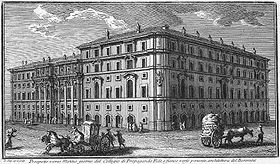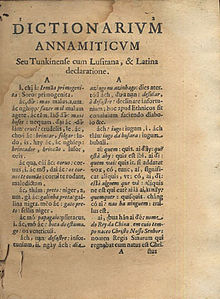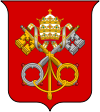- Congregation for the Evangelization of Peoples
-
 The headquarters of the Propaganda fide in Rome, North facade on Piazza di Spagna by architect Bernini, the southwest facade seen here by Borromini: etching by Giuseppe Vasi, 1761.[1]
The headquarters of the Propaganda fide in Rome, North facade on Piazza di Spagna by architect Bernini, the southwest facade seen here by Borromini: etching by Giuseppe Vasi, 1761.[1]
The Congregation for the Evangelization of Peoples (Congregatio pro Gentium Evangelizatione) in Rome is the congregation of the Roman Curia responsible for missionary work and related activities. It is perhaps better known by its former title, the Sacred Congregation for the Propagation of the Faith (Sacra Congregatio de Propaganda Fide).
It was founded by Pope Gregory XV in 1622 as the Congregation of Propaganda Fide, an organization to arrange missionary work on behalf of the various religious institutions and in 1627, Pope Urban VIII established a training college for missionaries. It was renamed by Pope John Paul II in 1982 and its mission continues unbroken.
The early Congregation was established in the Palazzo Ferratini, donated by Juan Bautista Vives, to the south of the Piazza di Spagna. Two of the foremost artistic figures of Baroque Rome were involved in the development of the architectural complex; the sculptor and architect Gianlorenzo Bernini and the architect Francesco Borromini.
The current Prefect of the Congregation is Archbishop Fernando Filoni. The current Secretary is Archbishop Savio Hon Tai-Fai from Hong Kong. The Archivist of the Archives of the Congregation is Bishop Luis Manuel Cuña Ramos.
Contents
Architecture
The Congregation was originally housed in a small palace, the Palazzo Ferratini, donated by Vives, a Spanish priest, at the southern end of the Piazza di Spagna. The architectural complex of the Propoaganda Fide was developed in the triangular urban block between the Via Due Macelli and the Via del Collegio di Propaganda Fide, two streets which diverged from the piazza.
In 1634 a small oval chapel was built according to designs by Bernini. In 1642, Father Valerio, with Bernini, redesigned the façade to the Piazza di Spagna, and the development was continued along the Via Due Macelli by Gaspare de’Vecchio from 1639-1645. [2]
In 1648, Borromini took over and made various proposals that included demolishing Bernini’s chapel which must have been particularly galling for the latter as he could see the building from his house on Via Mercede. [3] Initially Borromini designed an elongated oval chapel plan but this was superseded by a rectilinear design, with the greater length parallel to the street, and with curved corners on the interior. Construction of the chapel commenced in 1660 and although the main part was built by 1665, some of the decoration was carried out after his death. [4]
The Re Magi chapel, dedicated to the Three Kings, has a plan with four side chapels and galleries above. On the interior, the wall and the vault are differentiated horizontally by a cornice line but there is a vertical continuity of wall and vault which allows for windows at the base of the vault. The wall pilasters are continued in the vault as ribs that criss-cross and unite the space, unlike his design at the Oratory of Philip Neri Oratorio dei Filippini where the ribs are interrupted by the oval fresco at the centre of the vault. The criss cross arrangement in the Re Magi Chapel is such that an octagon is formed at the centre, embellished with a Dove of the Holy Spirit bathed in golden rays.
His first designs for the façade onto the Via di Propaganda Fide had five bays but he expanded this to seven. The façade is dominated by the giant pilasters that originally supported a balustrade above the narrow entablature but later extensions obliterated the balustrade. The central bay of the façade is a concave curve with angled pies at its edges, perhaps in recognition that this façade would always be seen at an oblique angle because of the narrowness of the street. The central door leads into the courtyard where Borromini intended a curved arcade but this was not built. [5] Only the left hand side of the façade relates to the chapel and the right to the stair and entrance to the College.
Other parts of the College have further minor works by Borromini.
History
 Alexandre de Rhodes' Dictionarium Annamiticum Lusitanum et Latinum, published by the Propaganda Fide in 1651.
Alexandre de Rhodes' Dictionarium Annamiticum Lusitanum et Latinum, published by the Propaganda Fide in 1651.
Founded in 1622 by Pope Gregory XV's bull Inscrutabili Divinae, the body was charged with fostering the spread of Catholicism and with the regulation of Catholic ecclesiastical affairs in non-Catholic countries. The intrinsic importance of its duties and the extraordinary extent of its authority and of the territory under its jurisdiction caused the Cardinal Prefect of Propaganda to be known as the "red pope".
At the time of its inception, the expansion of colonial administrations was coming to be largely in Dutch and English hands, both Protestant countries intent on spreading these religious doctrines, and Rome perceived the very real threat of Protestantism spreading in the wake of commercial empire. By 1648, with the end of the Thirty Years' War, the official religious balance of established Christianity in Europe was permanently stabilized, but new fields for evangelization were offered by vast regions of Asia, Africa and the Americas then being explored.
There had already been a less formally instituted cardinal committee concerned with propaganda fide since the time of Pope Gregory XIII (1572–1585), who were especially charged with promoting the union with Rome of the long-established eastern Christian communities: Slavs, Greeks, Syrians, Egyptians, and Abyssinians. This was the traditional direction for the Catholic Church to look for evangelizing. Catechisms were printed in many languages and seminarians sent to places as far as Malabar. The most concrete result was the union with Rome of the Ruthenian Catholic communion, most concentrated in modern day Ukraine and Belarus; the union was formalized at Brest in 1508.
The death of Gregory XV the following year did not interrupt the organization, because Cardinal Barberini, one of the original thirteen members of the congregation, became the next pope as Urban VIII (1623–1644). Under Urban VIII, a central seminary (the Collegium urbanum) was set up for training missionaries. The Congregation also operated the polyglot printing press in Rome, printing catechisms in many languages. Their procurators were especially active in China from 1705, moving between Macau and Canton before finally settling in Hong Kong in 1842.
In strongly Protestant areas, the operations of the Congregation were considered subversive: the first missionary to be killed was in Grisons, Switzerland, in April 1622, before the papal bull authorizing its creation had been disseminated. In Ireland after Catholic emancipation (1829), while the established church was still the Protestant Church of Ireland, the Irish Catholic church came under the control of the Congregation in 1833, and soon reformed itself with a devotional revolution under Cardinal Cullen.
These "Cardinals in General Congregation" met weekly, keeping their records in Latin until 1657, then in Italian. The minutes are available in microfilm (filling 84 reels) at large libraries. In the course of their work, the Propaganda fide missionaries accumulated the objects now in the Vatican Museum's Ethnological Missionary Museum.
Since 1989 the incumbent Prefect is also President of the Interdicasterial Commission for Consecrated Religious.
Prefects

This article is part of a series on the
Roman CuriaApostolic Constitution Pastor Bonus
TribunalsAdministrative Services
WikiProjects- WikiProject Roman Curia
- WikiProject Catholicism
- WikiProject Vatican City
- Antonio Maria Sauli (1622)
- Ludovico Ludovisi (1622–1632)
- Antonio Barberini (1632–1645)
- Luigi Capponi (1645-1649) (while Barberini was in exile during the pontificate of Innocent X)
- Antonio Barberini (1649–1671)
- Paluzzo Paluzzi Altieri degli Albertoni (1671–1698)
- Carlo Barberini (1698–1704)
- Giuseppe Sacripanti (1704–1727)
- Vincenzo Petra (1727–1747)
- Silvio Valenti Gonzaga (1747–1756)
- Giuseppe Spinelli (1756–1763)
- Giuseppe Maria Castelli (1763–1780)
- Leonardo Antonelli (1780–1795)
- Giacinto Sigismondo Gerdil (1795–1802)
- Stefano Borgia (pro-prefect 1798-1800, prefect 1802-1804)
- Antonio Dugnani (1804–1805)
- Michele di Pietro (1805–1814)
- Lorenzo Litta (1814–1818)
- Francesco Fontana (1818–1822)
- Ercole Consalvi (pro-prefect 1822-1824, prefect 1824)
- Giulio Maria della Somaglia (pro-prefect 1824-1826)
- Mauro Capellari (1826–1831) (elected as Pope Gregory XVI)
- Carlo Maria Pedicini (1831–1834)
- Giacomo Filippo Fransoni (1834–1856)
- Alessandro Barnabò (1856–1874)
- Alessandro Franchi (1874–1878)
- Giovanni Simeoni (1878–1892)
- Mieczysław Halka Ledóchowski (1892–1902)
- Girolamo Maria Gotti (1902–1916)
- Domenico Serafini (pro-prefect 1916, prefect 1916-1918)
- Willem van Rossum (1918–1932)
- Pietro Fumasoni Biondi (1933–1960)
- Samuel Stritch (pro-prefect 1958)
- Grégoire-Pierre Agagianian (pro-prefect 1958-1960, prefect 1960-1970)
- Agnelo Rossi (1970–1984)
- Dermot J. Ryan (pro-prefect 1984-1985)
- Jozef Tomko (pro-prefect 1985, prefect 1985-2001)
- Crescenzio Sepe (2001–2006)
- Ivan Dias (2006-2011)
- Fernando Filoni (pro-prefect 2011- )
References
- ^ Collegio di Propaganda Fide
- ^ Blunt, A. Guide to Baroque Rome, Granada, 1982, 246
- ^ Blunt, 1982, 166
- ^ Magnuson, T. Rome in the Age of Bernini, Vol 2, 206-7
- ^ Blunt, 1979, 246
External links
- Giga-Catholic Information
- Notre Dame University site gives history of the Propaganda Fide, with details of its organization
- the Collegio di Propaganda Fide: photos and history
- Official Propaganda Fide website
- Satellite Photo. The Collegio is the large rhomboidal block buildings that lie just south of the Spanish steps (narrow tip and Bernini facade facing northeast to Piazza di Spagna).
 "Sacred Congregation of Propaganda". Catholic Encyclopedia. New York: Robert Appleton Company. 1913.
"Sacred Congregation of Propaganda". Catholic Encyclopedia. New York: Robert Appleton Company. 1913.
Categories:- Roman Catholic missionary work
- Congregation for the Evangelization of Peoples
- 1622 establishments
- Religious organizations established in the 1620s
- Christian organizations established in the 17th century
Wikimedia Foundation. 2010.
